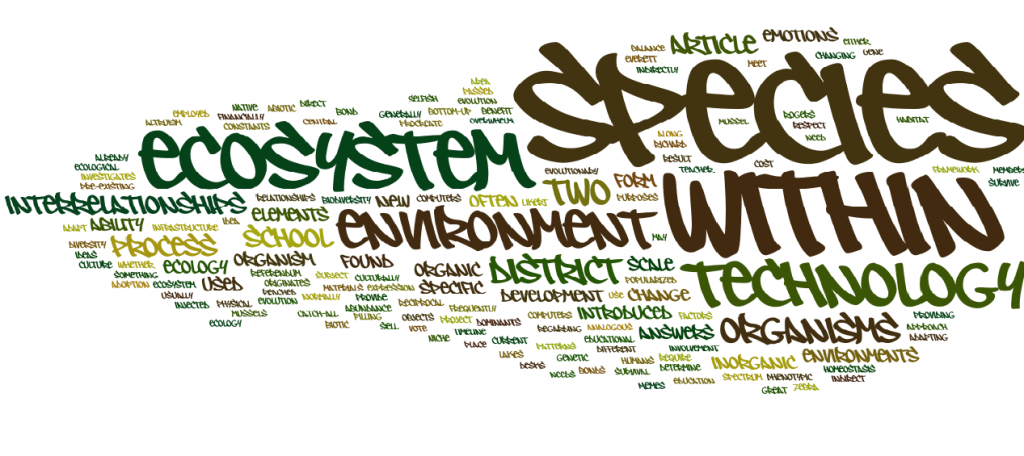For those that would be interested in a different format for learning or want some clarification, here is a talk by Young Zhao: http://gallery.crpp.nie.edu.sg/view_album.php?set_albumName=album09. Listen from 15:11 to 19:56 for a description of terms.
Abiotic: the inorganic materials within an ecosystem
Biodiversity: all the organisms and ecosystems within an area
Biotic: the organic elements within an ecosystem
Bond referendum: citizens within a district vote on whether or not to sell bonds to financially benefit a specific educational project within that district
Co-evolution: the process of two species within an ecosystem adapting to each other by changing themselves
Computers in schools: a new species that has been injected into a school or district environment
Diffusion of Innovation: a theory popularized by Everett Rogers that investigates the causes, process and timeline of the spread and adoption of new innovations in a culture
Dominants: a species that can overwhelm an ecosystem, often because of abundance
Ecological approach: the idea that issues can be explored through the concepts of ecology
Ecology: the study of interrelationships between all organisms and their environments
Ecosystem: the interrelationships between all organisms and their environments, contains species and all elements that they require to survive
Educational technology: a catch-all phrase with no exact definition, within it some form of technology being employed in some form of education are its two constants
Evolution: the process by which species change to adapt to their environment and organisms within it to meet their needs
Exotic species: a species not normally found within an ecosystem
Fecundity: ability to procreate
Habitat: the environment in which an organism lives and develops
Homeostasis: when a stable balance is reached within an ecosystem
Invasive species: a species not generally found in an ecosystem that gets introduced usually by direct or indirect human involvement
Keystone species: a species central to an ecosystem’s diversity and survival
Likert scale: a scale that is frequently used in questionnaires. It allows for answers that fall along a spectrum and is often used to determine patterns of emotions regarding a specific subject
Memes: ideas that are passed culturally for evolutionary purposes, the term originates from Richard Dawkins’ The Selfish Gene (1976)
Native species: a species that is pre-existing within an environment and has not been introduced directly or indirectly by humans
Niche: filling a need, or providing a function within an environment, in this article different technologies may fit in the same niche
Phenotypic plasticity: the ability of an organism to change its genetic expression as a result of changes in an environment, this can be an evolution in either physical development or behaviour
Reciprocal altruism: when two species provide benefits for one another, at the cost of something to themselves
School ecology: the interrelationships between all members of a school ecosystem in this article, organic and inorganic objects, such as desks and computers, are species within this ecosystem
Teacher development: bottom-up exposure and emotions about technology are two major factors that affect teacher relationships with technology
Technology infrastructure: the framework already in place in a school, classroom or district with respect to technology. It answers the who, what, why, where, how and when of current technology use
Zebra mussels: freshwater mussel and invasive species that has infiltrated the Great Lakes, in this article it is analogous to technology

